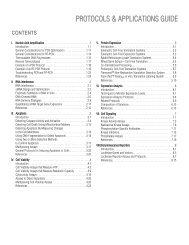2012 Promega catalogue
2012 Promega catalogue
2012 Promega catalogue
Create successful ePaper yourself
Turn your PDF publications into a flip-book with our unique Google optimized e-Paper software.
Life<br />
Science<br />
Catalog<br />
<strong>2012</strong><br />
Worldwide Contact List<br />
Section<br />
Contents<br />
Table of<br />
Contents<br />
Cell Signaling<br />
238<br />
Transcend Non-Radioactive Translation<br />
Detection Systems<br />
Product Size Cat.# Price ($)<br />
Transcend Colorimetric Translation<br />
Detection System<br />
Transcend Chemiluminescent Translation<br />
30 reactions L5070 377.00<br />
Detection System<br />
Available Separately<br />
30 reactions L5080 566.00<br />
Transcend tRNA 30 µl L5061 307.00<br />
For Research Use Only. Not for Use in Diagnostic Procedures.<br />
Description: The Transcend Non-Radioactive Translation Detection<br />
Systems allow non-radioactive detection of proteins synthesized in vitro.<br />
Using these systems, biotinylated lysine residues are incorporated into<br />
nascent proteins during translation, eliminating the need for labeling with [ 35 S]<br />
methionine or other radioactive amino acids. This biotinylated lysine is added<br />
to the translation reaction as a precharged ε-labeled biotinylated lysine-tRNA<br />
complex (Transcend tRNA) rather than a free amino acid. After SDS-PAGE<br />
and electroblotting, the biotinylated proteins can be visualized by binding either<br />
Streptavidin-Alkaline Phosphatase (Streptavidin-AP) or Streptavidin-Horseradish<br />
Peroxidase (Streptavidin-HRP), followed either by colorimetric or chemiluminescent<br />
detection. Typically, these methods can detect 0.5–5ng of protein<br />
within 3–4 hours after gel electrophoresis. This sensitivity is equivalent to that<br />
achieved with [ 35 S]methionine incorporation and autoradiographic detection<br />
6–12 hours after gel electrophoresis.<br />
Features:<br />
• Sensitive: The biotin tag allows detection of 0.5–5ng of translated protein.<br />
• Safe: No radioisotope handling, storage or disposal is required.<br />
• Fast: Labeled proteins can be detected 3–4 hours after gel electrophoresis.<br />
• Flexible: Results can be visualized by using colorimetric or chemiluminescent<br />
detection.<br />
Storage Conditions: Store Transcend tRNA at –70°C. Do not subject<br />
the Transcend tRNA to more than five freeze-thaw cycles. Store all other<br />
components at 4°C.<br />
Protocol Part#<br />
Transcend Non-Radioactive Translation Detection System<br />
Technical Bulletin<br />
TB182<br />
ECL Western Blotting Substrate<br />
Product Size Cat.# Price ($)<br />
ECL Western Blotting Substrate 250 ml W1001 247.00<br />
For Research Use Only. Not for Use in Diagnostic Procedures.<br />
500 ml W1015 387.00<br />
Description: The ECL Western Blotting Substrate is a highly sensitive<br />
non-radioactive, enhanced luminol-based chemiluminescent substrate for the<br />
detection of horseradish peroxidase (HRP) on immunoblots. The ECL Western<br />
Blotting Substrate detects picogram amounts of antigen, and with the use of<br />
photographic or other imaging methods, visualizes the presence of HRP.<br />
Features:<br />
• High Sensitivity: Detect picogram levels of protein.<br />
• Save Time: No optimization required; you can switch from other entrylevel<br />
ECL substrates.<br />
Storage Conditions: Store at 2–8°C.<br />
Protocol Part#<br />
ECL Western Blotting Substrate Technical Manual TM317<br />
TMB One Solution<br />
Product Size Cat.# Price ($)<br />
TMB One Solution<br />
For Laboratory Use.<br />
100 ml G7431 144.00<br />
For additional information see page 176.<br />
AttoPhos ® AP Fluorescent Substrate System<br />
Product Size Cat.# Price ($)<br />
AttoPhos ® AP Fluorescent Substrate System<br />
AttoPhos<br />
3 × 36 mg S1000 727.00<br />
® AP Fluorescent Substrate System<br />
Trial Size<br />
Available Separately<br />
1 × 36 mg S1001 295.00<br />
AttoPhos ® Substrate 36 mg S1011 192.00<br />
100 mg S1012 474.00<br />
1 g S1013 1884.00<br />
AttoPhos ® Buffer 60 ml S1021 114.00<br />
240 ml S1022 349.00<br />
For Research Use Only. Not for Use in Diagnostic Procedures.<br />
Description: AttoPhos ® AP Fluorescent Substrate System contains a highly<br />
sensitive fluorescent alkaline phosphatase (AP) substrate.<br />
Features:<br />
• Sensitivity: Low fluorescence signal until enzymatically acted upon, yielding<br />
detection of AP to 0.1 attomole.<br />
• Low Background: Low fluorescence from interfering biological molecules.<br />
• Linearity: Linear kinetics over five orders of magnitude of AP concentration.<br />
• Additional Features: Excitation at 435nm, emission at 555nm and large<br />
Stokes’ shift (≈120nm).<br />
Storage Conditions: Store at 4°C.<br />
Protocol Part#<br />
AttoPhos ® AP Fluorescent Substrate System Technical Bulletin TB280<br />
Blocking Agents<br />
Product Size Cat.# Price ($)<br />
Blot-Qualified BSA 10 g W3841 87.00<br />
Tween ® 20<br />
For Laboratory Use.<br />
2.5 ml W3831 53.00<br />
Description: This BSA (bovine serum albumin) has been tested and qualified<br />
for optimum performance in immunoblotting applications with alkaline phosphatase<br />
antibody conjugates. It is shown to be alkaline phosphatase-free.<br />
Tween ® 20 is a nonionic detergent used as a buffer component for immunoscreening<br />
in the ProtoBlot ® Systems. In addition to blocking agents<br />
such as BSA, which saturate excess sites of antibody binding on membranes,<br />
this detergent acts in solution to dissociate nonspecific interactions with an<br />
antibody probe.<br />
For complete and up-to-date product information visit: www.promega.com/catalog
















